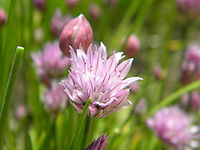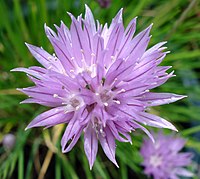
Back Grasui Afrikaans ቀጭን ሽንኩርት Amharic Secglēac ANG ثوم معمر Arabic ثوم معمر ARZ Allium schoenoprasum AST Mala soğanı Azerbaijani داغ سوغانی AZB Цыбуля скарада Byelorussian Сибирски лук Bulgarian
| Chives | |
|---|---|

| |

| |
| Scientific classification | |
| Kingdom: | Plantae |
| Clade: | Tracheophytes |
| Clade: | Angiosperms |
| Clade: | Monocots |
| Order: | Asparagales |
| Family: | Amaryllidaceae |
| Subfamily: | Allioideae |
| Genus: | Allium |
| Species: | A. schoenoprasum
|
| Binomial name | |
| Allium schoenoprasum | |
| Synonyms[2] | |
|
Synonymy
| |
 Cut chive leaves as used for preparing food | |
| Nutritional value per 100 g (3.5 oz) | |
|---|---|
| Energy | 126 kJ (30 kcal) |
4.35 g | |
| Sugars | 1.85 g |
| Dietary fiber | 2.5 g |
0.73 g | |
3.27 g | |
| Vitamins | Quantity %DV† |
| Vitamin A equiv. | 24% 218 μg24% 2612 μg323 μg |
| Thiamine (B1) | 7% 0.078 mg |
| Riboflavin (B2) | 9% 0.115 mg |
| Niacin (B3) | 4% 0.647 mg |
| Pantothenic acid (B5) | 6% 0.324 mg |
| Vitamin B6 | 8% 0.138 mg |
| Folate (B9) | 26% 105 μg |
| Vitamin C | 65% 58.1 mg |
| Vitamin E | 1% 0.21 mg |
| Vitamin K | 177% 212.7 μg |
| Minerals | Quantity %DV† |
| Calcium | 7% 92 mg |
| Iron | 9% 1.6 mg |
| Magnesium | 10% 42 mg |
| Manganese | 16% 0.373 mg |
| Phosphorus | 5% 58 mg |
| Potassium | 10% 296 mg |
| Zinc | 5% 0.56 mg |
| †Percentages estimated using US recommendations for adults,[3] except for potassium, which is estimated based on expert recommendation from the National Academies.[4] | |


Chives, scientific name Allium schoenoprasum, is a species of flowering plant in the family Amaryllidaceae that produces edible leaves and flowers.[5] Their close relatives include the common onions, garlic, shallot, leek, scallion,[6] and Chinese onion.[7]
A perennial plant, it is widespread in nature across much of Europe, Asia, and North America.[8][9][10][11][12][13]
A. schoenoprasum is the only species of Allium native to both the New and the Old Worlds.[14][15]
Chives are a commonly used herb and can be found in grocery stores or grown in home gardens. In culinary use, the green stalks (scapes) and the unopened, immature flower buds are diced and used as an ingredient for omelettes, fish, potatoes, soups, and many other dishes. The edible flowers can be used in salads.[16] Chives have insect-repelling properties that can be used in gardens to control pests.[17]
The plant provides a great deal of nectar for pollinators. It was rated in the top 10 for most nectar production (nectar per unit cover per year) in a UK plants survey conducted by the AgriLand project which is supported by the UK Insect Pollinators Initiative.[18]
- ^ Maxted, N. & Rhodes, L. (2016). Allium schoenoprasum. The IUCN Red List of Threatened Species 2016: e.T172256A19391728. doi:10.2305/IUCN.UK.2016-3.RLTS.T172256A19391728.en Downloaded on 05 January 2019.
- ^ Cite error: The named reference
plantlistwas invoked but never defined (see the help page). - ^ United States Food and Drug Administration (2024). "Daily Value on the Nutrition and Supplement Facts Labels". Retrieved 2024-03-28.
- ^ National Academies of Sciences, Engineering, and Medicine; Health and Medicine Division; Food and Nutrition Board; Committee to Review the Dietary Reference Intakes for Sodium and Potassium (2019). Oria, Maria; Harrison, Meghan; Stallings, Virginia A. (eds.). Dietary Reference Intakes for Sodium and Potassium. The National Academies Collection: Reports funded by National Institutes of Health. Washington, DC: National Academies Press (US). ISBN 978-0-309-48834-1. PMID 30844154.
- ^ LaFray, Joyce (1987). Tropic Cooking: The New Cuisine from Florida and the Islands of the Caribbean. Oakland: Ten Speed Press. p. 292. ISBN 0-89815-234-8.
- ^ Block, E. (2010). Garlic and Other Alliums: The Lore and the Science. Royal Society of Chemistry. ISBN 978-0-85404-190-9.
- ^ "AllergyNet — Allergy Advisor Find". Allallergy.net. Archived from the original on June 15, 2010. Retrieved April 14, 2010.
- ^ "World Checklist of Selected Plant Families: Royal Botanic Gardens, Kew". kew.org.
- ^ "Allium schoenoprasum in Flora of China @ efloras.org". www.efloras.org. Retrieved 2017-06-18.
- ^ Tardiff, B.; Morisset, P. (1990). "Clinal morphological variation of Allium schoenoprasum in eastern North America". Taxon. 39 (3): 417–429. doi:10.2307/1223088. JSTOR 1223088.
- ^ "Allium schoenoprasum in Flora of North America @ efloras.org". www.efloras.org. Retrieved 2017-06-18.
- ^ Altervista Flora Italiana, Erba cipollina, wild chives, Civette, Schnittlauch, Allium schoenoprasum L. includes photos, drawings, European distribution map, etc.
- ^ "Allium schoenoprasum - Plant Finder". mobot.org.
- ^ Ernest Small North American Cornucopia: Top 100 Indigenous Food Plants (2014), p. 230, at Google Books
- ^ James Cullen, Sabina G. Knees, H. Suzanne Cubey (Editors) The European Garden Flora Flowering Plants: A Manual for the Identification, p. 133, at Google Books
- ^ Cite error: The named reference
Linfordwas invoked but never defined (see the help page). - ^ Kaufman, Peter B; Thomas J Carlson; Kaufman B Kaufman; Harry L Brielmann; Sara Warber; Leland J Cseke; James A Duke (1999). Natural Products from Plants. Boca Raton: CRC Press. pp. 261. ISBN 9780849331343. 084933134X.
- ^ "Which flowers are the best source of nectar?". Conservation Grade. 2014-10-15. Archived from the original on 2019-12-14. Retrieved 2017-10-18.
© MMXXIII Rich X Search. We shall prevail. All rights reserved. Rich X Search


